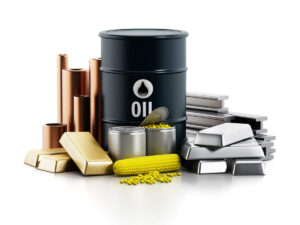Commodity Trading with AstroBulls


Overview
Commodity trading involves the buying and selling of physical goods, known as commodities, in the global financial markets. Commodities can be classified into several categories, including agricultural products (wheat, corn, coffee), energy resources (crude oil, natural gas), metals (gold, silver, copper), and others. In this article, we will explore the basics of commodity trading, its benefits, and how it works.
The following commodity exchanges are popular choices for trading in India
- Multi Commodity Exchange of India (MCX)
- Indian Commodity Exchange (ICEX)
- National Multi Commodity Exchange of India (NMCE)
- National Commodity and Derivative Exchange (NCDEX)
Features of Commodity Market Trading
Range of Commodities: The commodity market offers a wide range of commodities for trading, including agricultural products (such as wheat, corn, and soybeans), energy resources (such as crude oil and natural gas), metals (such as gold, silver, and copper), and other resources like coffee and cotton. Traders can choose to focus on specific commodities based on their knowledge and market insights.
Futures Contracts: Commodity trading is often conducted through futures contracts. A futures contract is an agreement between two parties to buy or sell a specific quantity of a commodity at a predetermined price and future date. These contracts are standardized and traded on regulated exchanges. Futures contracts provide traders with the ability to speculate on price movements without the need for physical ownership of the commodity.
Leverage and Margin: Commodity trading typically involves the use of leverage, which allows traders to control larger positions in the market with a smaller initial investment. Leverage amplifies both potential profits and losses. Traders are required to maintain a margin, which is a percentage of the total contract value, to cover potential losses. It is important to use leverage responsibly and understand the risks involved.
Price Volatility: Commodity markets are known for their price volatility. Factors such as supply and demand dynamics, geopolitical events, weather conditions, and government policies can cause significant fluctuations in commodity prices. Price volatility provides opportunities for traders to profit from short-term price movements.
How Commodity Market Trading Works:
Market Analysis: Successful commodity market trading begins with comprehensive market analysis. Traders analyze supply and demand factors, market trends, geopolitical events, weather conditions, and economic indicators to identify potential trading opportunities. Technical analysis, fundamental analysis, and market news play crucial roles in understanding price patterns and making informed trading decisions.
Choosing a Trading Strategy: Traders employ various trading strategies in the commodity market, depending on their risk appetite, time horizon, and market conditions. Some common strategies include trend following, mean reversion, breakout trading, and spread trading. Each strategy has its own set of rules and requires careful consideration of risk management techniques.
Placing Trades: Once a trading opportunity is identified, traders can enter the market by placing buy or sell orders. This can be done through online trading platforms provided by brokers or through direct market access platforms. Traders can choose between intraday trading, where positions are closed within the same trading day, or swing trading, where positions are held for a few days to weeks.
Monitoring and Managing Trades: Traders need to closely monitor their positions and adjust their strategies as market conditions evolve. This involves setting stop-loss orders to limit potential losses, trailing stop orders to protect profits, and taking profits at predetermined price levels.
What are Commodities?
Commodities are tangible goods that are either extracted from the earth (such as metals, oil, and gas) or grown (such as agricultural products). They are generally uniform in quality and have standardized units of measurement. Commodities can be classified into several categories:
Agricultural Commodities: These include grains (wheat, corn, soybeans), soft commodities (coffee, cocoa, sugar), livestock (cattle, hogs), and agricultural products like cotton.
Energy Commodities: These encompass crude oil, natural gas, gasoline, heating oil, and other energy-related products.
Metal Commodities: Metals include gold, silver, copper, platinum, aluminum, iron ore, and other precious and base metals.
Other Commodities: This category covers items such as natural resources (timber, water), chemicals, and certain industrial goods.
Advantages of Commodity Market Trading
Diversification: Commodity trading allows for diversification of investment portfolios. Commodities have historically exhibited low correlation with traditional asset classes like stocks and bonds, making them an attractive addition to a diversified portfolio.
Inflation Hedge: Commodities, particularly precious metals like gold and silver, have often been considered a hedge against inflation. As inflation rises, the value of commodities may increase, helping protect investors’ purchasing power.
Global Economic Exposure: Commodity market trading provides exposure to global economic trends. The prices of commodities are influenced by factors such as population growth, industrialization, emerging market development, and geopolitical events. Traders can take advantage of these trends
Conclusion
Commodity trading provides opportunities for diversification, inflation hedging, and participation in global economic trends. By trading commodities, investors can potentially profit from price fluctuations and manage risk. However, it is crucial to have a solid understanding of market dynamics, perform thorough research, and implement risk management strategies to navigate the complexities of commodity trading successfully.